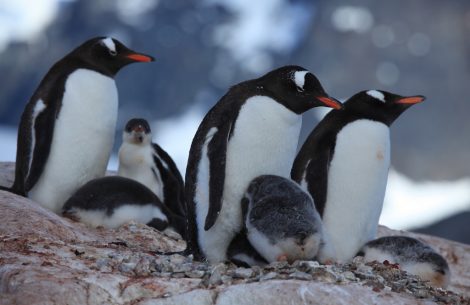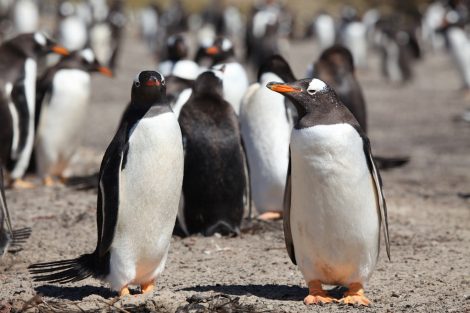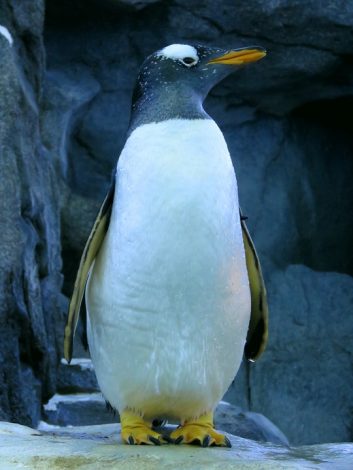Gentoo penguins are fresh-looking penguin species that live in Antarctic Peninsula and sub- Antarctic Islands. They have a long tail and a unique white patch on the head. They are easy to differentiate from the closest family member Adelie and Chinstrap penguins.
They are found in Carcass Island in Falklands, South Georgia, the Crozet Islands, Kerguelen Islands, Heard Islands, South Orkney Islands, South Shetland Islands, Saunders Islands, and Macquarie Islands. Some information states that few juveniles spotted in New Zealand, Australia, and South Africa.
Gentoo penguins at Jougla Point, Antarctica
The Habitat of Gentoo:
Gentoo penguins live in a wide range of lands that include rocky shorelines, ice-covered regions, areas that are good in vegetation, sheltered valleys, cliffs and also in cold temperate waters. The Antarctic is their common area to make their habitat and cannot find them endemic to any other places except when they are in captivity. Gentoo penguins breed only on ice-free areas even though they live in Antarctica.
Gentoo penguins at Saunders Islands
Appearance and Their Adaptation to Antarctic Peninsula:
Gentoo penguins are the third-largest penguin species after Emperor and King Penguins. They breed in gathered colonies that consist of thousands of pairs. Gentoos reach a height up to 90 cm and the average adult Gentoo penguin stand tall with a height of 75 cm. The adult penguin can weigh up to 8 kg.
Gentoo penguin has pale orange webbed foot and bright orange bill. The long brush-like tail is strong and helps in defending the opponent especially skuas. The black and white plumage acts as water-resistant and also protects them from cold. The camouflaged body coloration prevents them from the predators that watch them from above the water or below the water.
The strong webbed foot has a tough covering that protects them from severe cold damage. They are not aggressive with other species except for protecting their nests. Also, the strong tail protects their bottom from completely touching the icy ground when they sit for incubating the eggs.
Gentoo penguin Calgary zoo
Gentoos build nests using stones and the interesting fact is that the males gift the stones to the females during the nesting time. In cold Antarctica, there is always a fight for collecting stones and sometimes involves a hard fight.
Chicks form the group to keep themselves warmer and train for their future in the Antarctic Peninsula. They are the shyest of all the penguin species and do not take up fight unnecessarily.
During molting, the Gentoo penguins fast for the season and they do not swim in the water to avoid the extreme cold affecting the body. They are social penguins and do not like to be far from the colonies during the breeding season.
Breeding Regions:
Gentoos biology during breeding season depends on the breeding locations. Gentoo penguins can dive up to 200 meters deep and stay in the water for 7 minutes. They are good divers and swimmers and can swim at the speed of 36 kph. In colder regions like subantarctic islands, Gentoo penguins lay eggs in June and in warmer regions like Antarctic Peninsula they lay eggs in December.
They usually breed in the cold waters of southern oceans like the Atlantic, Indian Ocean, and the Pacific Ocean. The temperature also plays an important role in their breeding season behaviors.
The egg-laying time in the Falkland Islands ranges between 135 days to154 days. In the other southern regions, it happens between 16- 28 days.
Food:
Gentoo penguins’ diet varies from region to region. And their usual prey includes small fishes, invertebrates like crustaceans and squids.
Predators:
Adult Gentoo penguins are endangered by southern elephant seals, killer whales, sharks, and leopard seals. Chicks, eggs and younger penguins fall in the menu of sheathbills, caracaras, kelp gulls, giant petrels, skuas and feral cats.
Status of Gentoo Penguins:
The Falkland Islands was the vulnerable place where the Gentoo penguins and their eggs destroyed. Luckily, Gentoo penguins are the growing species in the Antarctic Peninsula. They are in the least concern red list for their declining numbers due to oil pollution, water pollution, and human interruption.
Conclusion:
Gentoo penguins stay in the same place where they breed. We can find them in large numbers in southern oceans like the Falkland Islands and distributed in the south of the Antarctic Peninsula.
Gentoos that are endemic to the further north are bulkier and taller than the ones in the south. Oil probe and tourist interruption affect the Falkland penguins’ environment significantly. Also, the Falkland Islands’ land is disturbed by grazing animals such as sheep and cattle which destroy the Gentoo penguins’ nest.
An interesting fact about Gentoo penguins is, they love cleanliness and they shift their nesting place when it is seen clumsy. The colonies move to coastlines after a year of staying in the land which turned to be unclean.
References:
http://www.antarctica.gov.au/about-antarctica/wildlife/animals/penguins/gentoo-penguins
https://travelwild.com/wildlife/antarctica-wildlife/gentoo-penguin/
https://travelwild.com/wildlife/antarctica-wildlife/gentoo-penguin/
Image Source:
#gentoo #live #penguins #where-do


